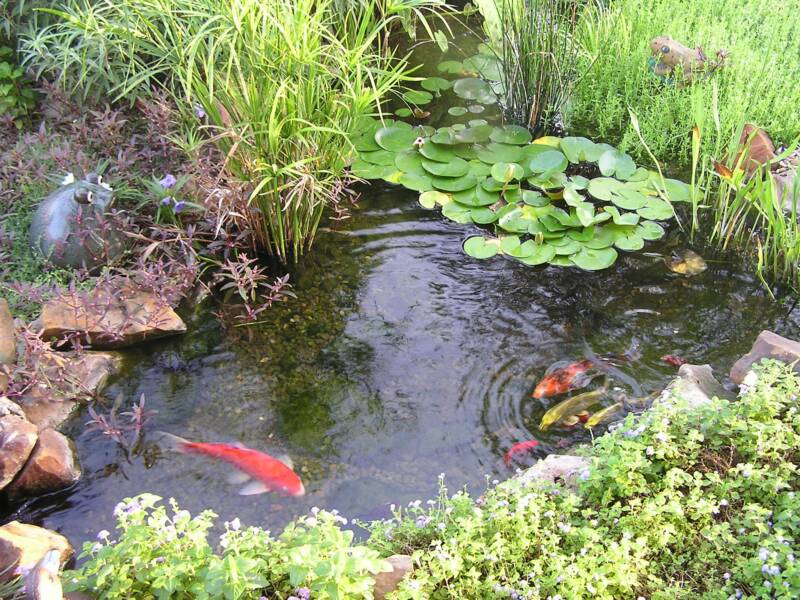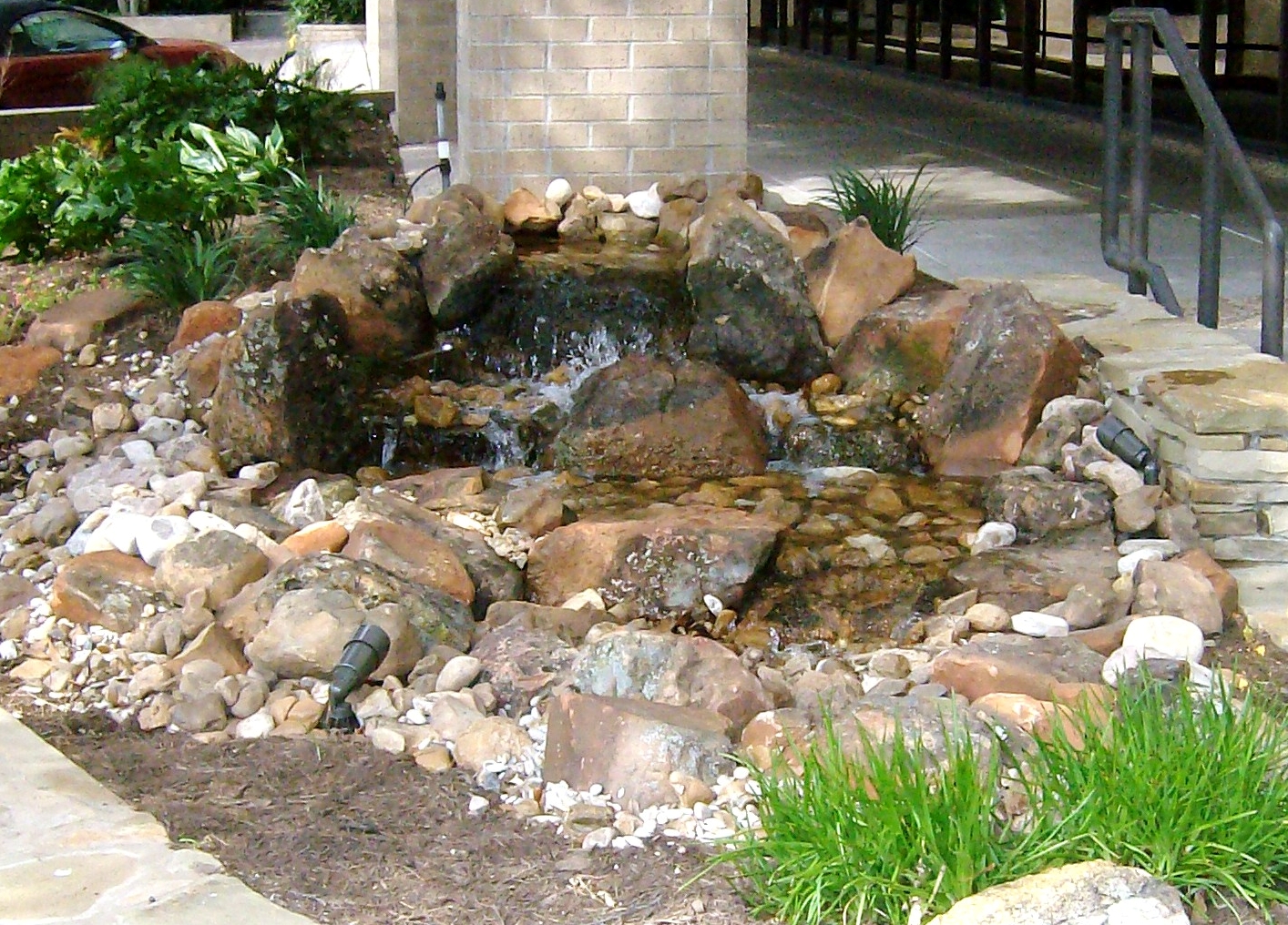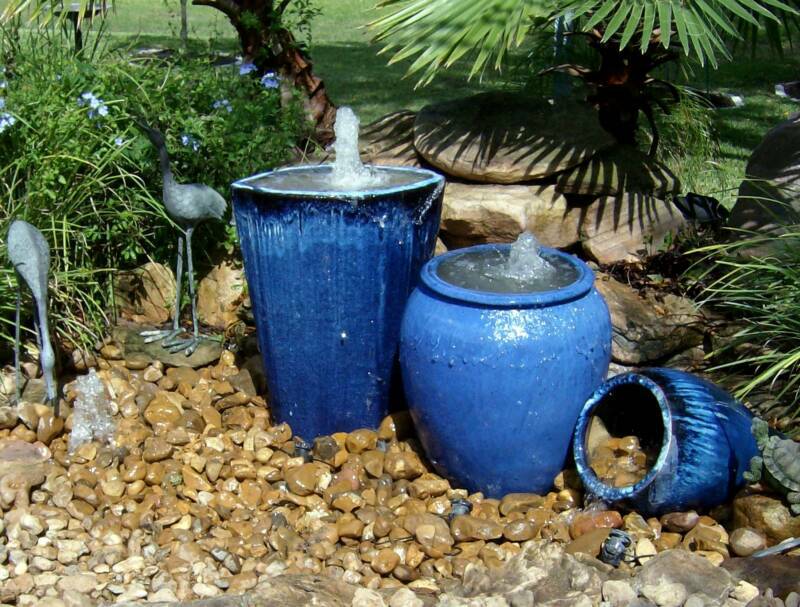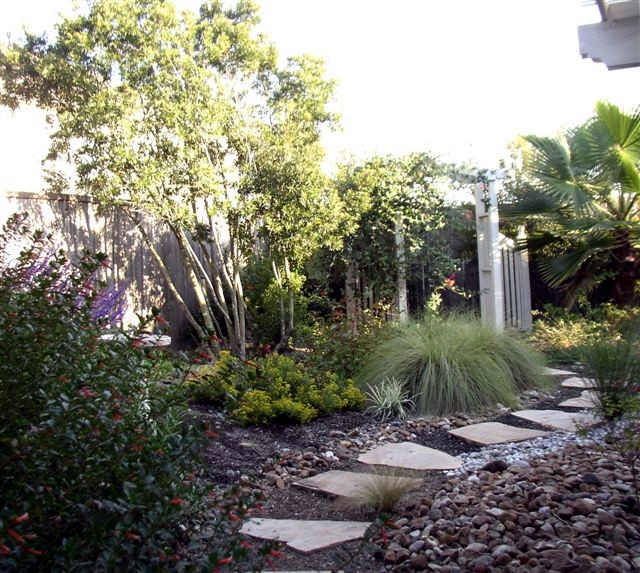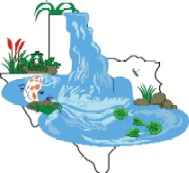


Rainwater Harvesting
Organic Ecosystem Ponds
Pondless Waterfalls
Urn and Fountain Features
Water-Wise Landscapes
Meet Your Water Feature Professionals


Texas Ponds and
Water Features
To Gravel or Not To Gravel
by Matt Boring
The Natural Water Gardener
One of the biggest controversies in organic vs. traditional water garden philosophies is the use of rocks and gravel in the pond itself. People who use other systems insist that rock and gravel in the pond makes the pond impossible to clean, it’s dangerous to the fish, it harbors anaerobic bacteria, interferes with the bottom drain, and other things that may not be suitable to print here. They usually insist that ponds should be built out of concrete or with the black liner exposed and possibly a ring of boulders or flagstones around the top edge. However, as someone who builds ponds for a living, I can tell you that a properly-designed and constructed organic water feature must have rocks and gravel in it. And I can tell you that all the things the nay-sayers are saying are based on the fact that the methods employed by organic water gardeners may not work in a traditionally built system, so they can’t perceive that they’ll work for us either. However, I contend that when you design a system that encourages Mother Nature to just do her thing, you can have a much more beautiful and lower maintenance water feature that does contain natural rocks and gravel. I’ve built close to a hundred ponds and every one of them is lined with the stuff.
There are several reasons to rock an organic pond. First off, the rocks and gravel offer suitable surface area for millions of beneficial bacteria to colonize in the pond itself, in addition to those in the biological filter. These bacteria help break down the fish’s waste and convert it to usable plant fertilizer. In effect, when you construct your water garden with rocks and gravel, you turn your entire pond into a giant biological filter, constantly working to keep your pond clean and your water clear. A plain black liner will not be suitable surface area for this kind of colonization. That’s why you tend to see a lot of sludge build-up in black liner ponds that don’t have a bottom drain. This sludge must be removed each year during the clean out. Organic ponds seldom have even 1/8" of sediment built up in the course of a year.
Let’s address the issue of bottom drains since it came up. Certainly a graveled pond bottom would interfere with the proper functioning of a bottom drain. However we don’t use bottom drains for a couple of reasons. First off, we don’t need them. Bottom drains help get rid of the sludge that forms on the pond’s bottom. We don’t get that sludge, so there’s no need to drain it out. Secondly, why cut a hole in the bottom of your liner if you don’t need to? It’s just a ticking time bomb waiting to spring a leak. And if it does it when you’re not around, it can drain your pond and leave all your fish high and dry. A properly built pond with a skimmer can only lose 3-4" of water before it shuts off the pump, leaving your fish in plenty of water. When we need to drain the pond, which is no more than once a year, we can stick a pump in the bottom of the pond and pump it out, giving you the effect of a bottom drain without the risk.
It’s true that if you have too much gravel on the bottom of the pond, it can harbor unwanted bacteria. But by using no more than 2" of gravel, there is a healthy balance of all the natural bacteria. Anaerobic bacteria are found in Mother Nature’s water systems too. They’re just in a healthy balance with aerobic bacteria.
Rocks and gravel also serve other important and useful purposes in a water garden. By building the pond in several levels and lining the walls of each level with small boulders, you get much more structural integrity than in a pond with the sides dug straight down. When the ground around the pond gets wet, it tends to swell up and press in on the sides of the pond. A rubber-lined pond has nothing to help support its structure. But a shelved pond supported by rock has plenty of strength to handle this pressure. Putting a row of boulders around only the top edge of the pond is even worse because these tend to sink over time and, rather than support anything, they actually help collapse the walls of the pond.
Lining the entire pond with natural rocks and gravel also protects the liner from harmful UV rays and can double the life of the liner because of it. UV rays are killers not only to our skin, but also to the EPDM liners. In fact UV rays are the number one factor in liner deterioration. And since you can’t ArmorAll the bottom of the pond, you better try to shade the liner as best you can. The liner I use has a twenty-year warranty and a forty-year life expectancy. But by hiding it from the UV rays, I can just about count on eighty to a hundred years. That becomes a very important difference when you’re the customer.
In an organic pond, plants are a very important part of the natural filtration of the pond. Rather than keeping their root systems in pots and having to add plant fertilizer to the system, we let most plants out of their pots, where they are forced to take nutrients directly from the pond’s water. They literally starve the algae out of the system! In order to let the plants out of their pots, you have to have something for them to root out into. That’s another important reason to have gravel lining your pond. In traditional water gardening, you have to add plant fertilizer to the potted aquatic plants. This usually causes an algae bloom from the excess nutrients suddenly introduced into the water. Then you add chemicals to kill the algae. There’s no such thing as balance. It’s definitely not what nature does. In nature who feeds the fish, fertilizes the plants, and adds the algae killer?
What are the Koi and other fish supposed to do in a garden pond? These guys are natural bottom feeders and their instinct is to root around on the bottom of a body of water looking for organic material to consume. That’s why Koi have those little whiskers on the sides of their mouths, so they can feel around in murky water. In a traditional pond, these little guys have nothing to do all day but swim around and around. I’m sure they don’t like rooting around in inches of their own waste, so they just swim around bored. They may even knock over your aquatic plants trying to root around in the dirt or gravel that they’re potted in. However, in an organic pond, their job is to keep the pond clean. You can watch them all day mouthing the rocks and gravel of the pond, spitting the gravel back out, and picking up more. They’re not bored at all. It’s a lot more natural and I feel it’s less stressful to the fish. And since they’re also an important part of the ecosystem, we want to keep them as healthy and happy as we can.
Finally, using rocks and gravel in a water garden simply looks better and a lot more natural than not using them. All the customers I’ve ever had wanted to put a natural looking water feature in their yards. I’ve never had anyone ask for a swimming pool for their fish. By using tons of natural rock and gravel in their ponds, I’ve given them what they wanted– a low-maintenance, natural-looking, naturally-functioning ecosystem that almost takes care of itself and looks great doing it.
Hopefully I’ve helped clear up some myths about rocks and gravel in your pond. Now when someone asks you how we build a proper water garden you can honestly say, “We rock!”
Happy Pondering!

